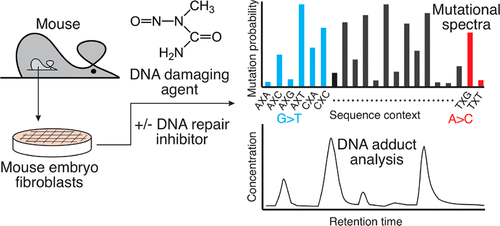当前位置:
X-MOL 学术
›
Chem. Res. Toxicol.
›
论文详情
Our official English website, www.x-mol.net, welcomes your
feedback! (Note: you will need to create a separate account there.)
Modulation of N-Methyl-N-nitrosourea Mutagenesis in Mouse Embryo Fibroblasts Derived from the gpt Delta Mouse by an Inhibitor of the O6-Methylguanine Methyltransferase, MGMT.
Chemical Research in Toxicology ( IF 3.7 ) Pub Date : 2019-12-24 , DOI: 10.1021/acs.chemrestox.9b00444 Pennapa Thongararm 1, 2 , Bogdan I Fedeles 1 , Sakunchai Khumsubdee 1, 2 , Amanda L Armijo 1 , Lina Kim 1 , Apinya Thiantanawat 2 , Jeerawan Promvijit 2 , Panida Navasumrit 2 , Mathuros Ruchirawat 2 , Robert G Croy 1 , John M Essigmann 1
Chemical Research in Toxicology ( IF 3.7 ) Pub Date : 2019-12-24 , DOI: 10.1021/acs.chemrestox.9b00444 Pennapa Thongararm 1, 2 , Bogdan I Fedeles 1 , Sakunchai Khumsubdee 1, 2 , Amanda L Armijo 1 , Lina Kim 1 , Apinya Thiantanawat 2 , Jeerawan Promvijit 2 , Panida Navasumrit 2 , Mathuros Ruchirawat 2 , Robert G Croy 1 , John M Essigmann 1
Affiliation

|
DNA methylating agents are abundant in the environment and are sometimes used in cancer chemotherapy. They react with DNA to form methyl-DNA adducts and byproduct lesions that can be both toxic and mutagenic. Foremost among the mutagenic lesions is O6-methylguanine (m6G), which base pairs with thymine during replication to cause GC → AT mutations. The gpt delta C57BL/6J mouse strain of Nohmi et al. (Mol. Mutagen 1996, 28, 465-70) reliably produces mutational spectra of many DNA damaging agents. In this work, mouse embryo fibroblasts (MEFs) were made from gpt delta C57BL/6J mice and evaluated as a screening tool to determine the qualitative and quantitative features of mutagenesis by N-methyl-N-nitrosourea (MNU), a direct-acting DNA alkylator that serves as a model for environmental N-nitrosamines, such as N-nitrosodimethylamine and therapeutic agents such as Temozolomide. The DNA repair protein MGMT (O6-methylguanine DNA methyltransferase) protects against environmental mutagenesis by DNA methylating agents and, by removing m6G, limits the therapeutic potential of Temozolomide in cancer therapy. The gpt delta MEFs were treated with MNU to establish dose-dependent toxicity. In parallel, MNU mutagenicity was determined in the presence and absence of the MGMT inhibitor AA-CW236 (4-(2-(5-(chloromethyl)-4-(4-(trifluoromethoxy)phenyl)-1H-1,2,3-triazol-1-yl)ethyl)-3,5-dimethylisoxazole). With and without the inhibitor, the principal mutagenic event of MNU was GC → AT, but more mutations were observed when the inhibitor was present. Evidence that the mutagenic lesion was m6G was based on mass spectral data collected using O6-methyl-d3-guanine as an internal standard; m6G levels were higher in AA-CW236 treated MEFs by an amount proportional to the higher mutation frequency seen in the same cells. This work establishes gpt delta MEFs as a versatile tool for probing mutagenesis by environmental and therapeutic agents and as a cell culture model in which chemical genetics can be used to determine the impact of DNA repair on biological responses to DNA damaging agents.
中文翻译:

O6-甲基鸟嘌呤甲基转移酶 (MGMT) 抑制剂对 gpt Delta 小鼠小鼠胚胎成纤维细胞中 N-甲基-N-亚硝基脲诱变的调节。
DNA 甲基化剂在环境中含量丰富,有时用于癌症化疗。它们与 DNA 发生反应,形成甲基 DNA 加合物和可能具有毒性和诱变性的副产物损伤。其中最主要的诱变损伤是 O6-甲基鸟嘌呤 (m6G),它在复制过程中与胸腺嘧啶碱基配对,导致 GC → AT 突变。 Nohmi 等人的 gpt delta C57BL/6J 小鼠品系。 (Mol. Mutagen 1996, 28, 465-70) 可靠地产生许多 DNA 损伤剂的突变谱。在这项工作中,小鼠胚胎成纤维细胞 (MEF) 由 gpt delta C57BL/6J 小鼠制备,并作为筛选工具进行评估,以确定 N-甲基-N-亚硝基脲 (MNU)(一种直接作用的诱变剂)诱变的定性和定量特征。 DNA 烷化剂可作为环境 N-亚硝胺(例如 N-亚硝基二甲胺)和治疗剂(例如替莫唑胺)的模型。 DNA 修复蛋白 MGMT(O6-甲基鸟嘌呤 DNA 甲基转移酶)可防止 DNA 甲基化剂引起的环境诱变,并通过去除 m6G 限制替莫唑胺在癌症治疗中的治疗潜力。用 MNU 处理 gpt delta MEF 以确定剂量依赖性毒性。同时,在存在和不存在 MGMT 抑制剂 AA-CW236 (4-(2-(5-(氯甲基)-4-(4-(三氟甲氧基)苯基)-1H-1,2,3 -三唑-1-基)乙基)-3,5-二甲基异恶唑)。无论有或没有抑制剂,MNU的主要诱变事件是GC→AT,但当抑制剂存在时观察到更多突变。 诱变病变是 m6G 的证据是基于使用 O6-甲基-d3-鸟嘌呤作为内标收集的质谱数据; AA-CW236 处理的 MEF 中 m6G 水平较高,其量与相同细胞中观察到的较高突变频率成正比。这项工作将 gpt delta MEF 建立为一种多功能工具,用于探测环境和治疗剂引起的诱变,并作为细胞培养模型,其中化学遗传学可用于确定 DNA 修复对 DNA 损伤剂的生物反应的影响。
更新日期:2019-12-25
中文翻译:

O6-甲基鸟嘌呤甲基转移酶 (MGMT) 抑制剂对 gpt Delta 小鼠小鼠胚胎成纤维细胞中 N-甲基-N-亚硝基脲诱变的调节。
DNA 甲基化剂在环境中含量丰富,有时用于癌症化疗。它们与 DNA 发生反应,形成甲基 DNA 加合物和可能具有毒性和诱变性的副产物损伤。其中最主要的诱变损伤是 O6-甲基鸟嘌呤 (m6G),它在复制过程中与胸腺嘧啶碱基配对,导致 GC → AT 突变。 Nohmi 等人的 gpt delta C57BL/6J 小鼠品系。 (Mol. Mutagen 1996, 28, 465-70) 可靠地产生许多 DNA 损伤剂的突变谱。在这项工作中,小鼠胚胎成纤维细胞 (MEF) 由 gpt delta C57BL/6J 小鼠制备,并作为筛选工具进行评估,以确定 N-甲基-N-亚硝基脲 (MNU)(一种直接作用的诱变剂)诱变的定性和定量特征。 DNA 烷化剂可作为环境 N-亚硝胺(例如 N-亚硝基二甲胺)和治疗剂(例如替莫唑胺)的模型。 DNA 修复蛋白 MGMT(O6-甲基鸟嘌呤 DNA 甲基转移酶)可防止 DNA 甲基化剂引起的环境诱变,并通过去除 m6G 限制替莫唑胺在癌症治疗中的治疗潜力。用 MNU 处理 gpt delta MEF 以确定剂量依赖性毒性。同时,在存在和不存在 MGMT 抑制剂 AA-CW236 (4-(2-(5-(氯甲基)-4-(4-(三氟甲氧基)苯基)-1H-1,2,3 -三唑-1-基)乙基)-3,5-二甲基异恶唑)。无论有或没有抑制剂,MNU的主要诱变事件是GC→AT,但当抑制剂存在时观察到更多突变。 诱变病变是 m6G 的证据是基于使用 O6-甲基-d3-鸟嘌呤作为内标收集的质谱数据; AA-CW236 处理的 MEF 中 m6G 水平较高,其量与相同细胞中观察到的较高突变频率成正比。这项工作将 gpt delta MEF 建立为一种多功能工具,用于探测环境和治疗剂引起的诱变,并作为细胞培养模型,其中化学遗传学可用于确定 DNA 修复对 DNA 损伤剂的生物反应的影响。











































 京公网安备 11010802027423号
京公网安备 11010802027423号